Last builds of completed models of 2015: Airfix 1/72 Blenheim Mk. IF and Mk. IV
Last builds of the year, the beautiful little Airfix Blenheims. Since between the two kits together there are parts to mix-and-match to create different versions than OOB, I used the gun tray from the Mk.IV kit to turn the other into a Blenheim IF (Airfix is releasing this in 2016) of 29 Squadron in early 1940, that might likely have been flown by new Pilot Officer Guy Gibson. The Mk. IVF kit has the parts to do the bomber version, with both early and late chin turrets provided. This is done as the Blenheim flown by Wing Commander Hughie Edwards on the july 4, 1941 mission to Bremen for which he was awarded the Victoria Cross. Xtradecals used for both, with some mix-and-match to do Edwards' airplane. The kits are stunners and certainly replace the ancient Frog Mk.I and Airfix Mk.IV. Do wrap the cowlings with rubber bands to squeeze them to fit. If you are careful to clean up the parts and leave no sprue nubs, etc., you don't need any filler.
Such was the pace of aircraft development in the latter half of the 1930s that the Bristol Blenheim, which was the most modern aircraft in Britain when the Type 142 prototype first flew on April 12, 1935, was close to obsolete when called to war a mere four and a half years later. Indeed, sending unescorted Blenheims against German targets in daylight, which happened until 1942, could be seen as the World War II equivalent of sending pilots over the Western Front in 1916 in the B.E.2c or ordering the Charge of the Light Brigade.
The Blenheim was the result of Daily Mail owner Lord Rothermere, who had grown increasingly concerned that the British aviation industry was falling behind international standards, issuing a challenge in 1934 to develop a fast twin-engine aircraft which he
could use as a personal transport. As it happened, Bristol's chief designer, Frank Barnwell, had commenced development of a twin-engine passenger aircraft with a designed cruising speed of 250 mph - faster than every RAF fighter at the time - the
previous year. The result was the Type 142 “Britain First,” a 6-passenger aircraft with a maximum speed of 307 mph. The Air Ministry was immediately interested after Lord Rothermere donated the Type 142 to the RAF. Barnwell had already foreseen the
possibility of modifying the plane as a high speed light bomber, and the RAF ordered 150 before the bomber prototype had flown.
Named Blenheim in memory of the Duke of Marlborough's defeat of the French at Blenheim, Bavaria in 1704, the Blenheim I had a crew of three: pilot, bomb aimer/navigator, and gunner, and could carry a 1,000 pound bombload at 282 mph. Handling was “fighter-like” and maneuverability was excellent. The first Blenheim Is arrived in service in March 1937.
In 1938, in answer to the need for a long range fighter capable of operating at night, the Blenheim Mk.IF appeared, modified with a package of four .303 machine guns bolted over the bomb bay doors below the cockpit. With the extra weight of guns and
ammunition, top speed dropped to 260 mph.
Following the success of the Blenheim I, Bristol pursued further development of the basic airframe with a design originally called the Bolingbroke, in which the nose of the Blenheim I was extended forward 3 feet. With the windscreen that far from the pilot,
visual distortion set in; a more conventional "stepped cockpit, with the glass nose scalloped directly ahead of the pilot to allow good downward visibility during landing, was developed. From the rear cockpit bulkhead aft, the airframe was essentially unchanged except for the installation of gas tanks in the outer wings for extended range. The final form was approved in the summer of 1938. Bristol and the other contractors building Blenheims in the "shadow factory" program were directed to change over to what was now called the Blenheim IV in late 1938. By the outbreak of war in September, 1939, 100 Blenheim IVs a month were being delivered to the RAF. Though the airplane was outclassed by its opposition, it would be the primary tactical day bomber of the RAF until replaced by the Mosquito in 1942.
Though Blenheims had seen combat from the first day of the war, being the first British bomber to raid Germany when one flew a reconnaissance mission over the German fleet at Wilhelmshaven two hours after the declaration of war on September 3, 1939, the Blenheim did not see widespread combat until the German invasion of France in May, 1940. From then until the fall of 1941, Blenheim crews would almost see too much action.
The experience of 82 Squadron in 1940 is exemplary of the other squadrons equipped with the Blenheim. The squadron made its first attack against the German invasion in Belgium on May 17, 1940, when 12 aircraft crossed the Channel to attack a German
armored column in Gembloux, Belgium. They missed their rendezvous with the Hurricane squadron detailed to escort them, and pressed on regardless. Just before reaching Gembloux they were intercepted by 15 Bf-109s, which proceeded to shoot down all but one of the Blenheims. Thus began the crucifixion of the Blenheim crews in 2 Group. Basil Embry had lost 7 of 28 attacking the Maastricht bridges four days earlier. Between May 10 and the evacuation of the B.E.F from Dunkirk, the RAF lost 60 Blenheims with their crews to Luftwaffe fighters and deadly light flak no one had expected.
On August 13, 1940, 82 Squadron was ordered to attack the German airfield at Aalborg, Denmark. There was no prospect that the attack would meet with success, or that if it did it would have any effect on the air battles over England since the German
aircraft using the field were not participating in these operations. Even Sir Charles Portal, Chief of the Air Staff, had told the Air Ministry, "It seems to me the height of folly to throw away the experienced crews on the bombing of aerodromes which, I think you will agree, shows the least result for loss of equipment expended on it." The attack was made in a cloudless sky. The lead crew included a navigator flying his first mission, whose inexperience showed when the formation made landfall on the southern coast of Denmark, rather than the northern tip. As they crossed the shoreline, a Sgt. Pilot who would later be court-martialled for “Lacking Moral Fibre” aborted the mission. The eleven remaining flew the length of the country in clear skies at 8,000 feet, with the German defenses thoroughly alerted. As Lord Haw-Haw later reported accurately, five were shot down by fighters and six by flak; 9 aircrew of 33 survived as prisoners.
Through the summer of 1940, 2 Group Blenheim squadrons made daylight attacks in formations of 4-6 aircraft against the invasion ports and the buildup of the German Army in northern France. 82 squadron had suffered 180 percent casualties by September 1, going through 3 commanders in one week alone. Life in a 2 Group Blenheim squadron during the summer of 1940 has been compared to that of an RFC squadron on the Somme in 1916, with aircrews being lost on operations before they had completed the process of signing in to the squadron and being issued their bedding. It was considered by aircrew during this period that an assignment to 2 Group was effectively a death sentence. (In the recent film “Mr. Holmes,” which I highly highly highly recommend - Sherlock Holmes is 93 in 1947 - the housekeeper tells her son
with great bitterness that his father was trained as a gunner in the RAF and was “lost on his first mission in a Blenheim Mark IV.”)
The Air Staff was unwilling to admit that the RAF did not have a bomber capable of operating in the European air combat environment in daylight. 4-6 plane packets of Blenheims were shot down like ducks during season by the Luftwaffe. Even worse was the wastage of the pre-war trained aircrews, almost none of whom would survive the war, with the overwhelming majority lost by the end of 1940 to no good purpose.
When the RAF decided to "lean forward into France" in early 1941, 6-8 Blenheims would be escorted by up to eight wings of Spitfires and Hurricanes providing cover in and out for raids against the airfields used by JG26 and JG2. Losses averaged two Blenheims per mission, with Germans like Adolph Galland diving through the escort to blast a Blenheim from the sky as they kept on diving out of range. Between March and June 1941, Galland himself scored 10 Blenheims this way, including two on one day.
Beginning in the summer of 1941, 2 Group's Blenheims were detailed to support Coastal Command in Channel shipping strikes. This usually involved 2-4 Blenheims going up against a convoy that always included at least one flak ship. A tour of shipping
strike operations during this period lasted two weeks, with the squadron decimated by losses of 25 to 70 percent in those 14 days. The strikes were ordered by so that it could be shown Britain was still an island fortress that could strike the enemy.
Churchill minuted on August 29, 1941: "The loss of seven of seventeen in the daylight attack on merchant shipping and docks at Rotterdam is most severe. Such losses might be accepted in attacking the Scharnhorst, Gneisenau, or Tirpitz, or a southbound
Tripoli convoy, because, apart from the damage done, a first class strategic object is served. But they seem disproportionate to an attack on merchant shipping not engaged in vital supply work. While I greatly admire the bravery of the pilots, I do not want them pressed too hard." By that fall, a run of very bad weather and the reassignment of Air Marshal Donald "Butcher" Stevenson as AOC finally saved what was left of the Blenheims of 2 Group.
Wing Commander Hughie I. Edwards:
Born August 1, 1914 to Welsh immigrants in Fremantle, Australia, Hughie Edwards was forced by family circumstances to leave school at age 14, eventually becoming a trainer of race horses before joining the Australian Army at age 19 in 1933. In 1935 he won an
appointment to the RAAF; after flight training, he received a short-term commission in the RAF and arrived in England in August 1936, where he was assigned to 15 Squadron flying Hawker Hinds. In March 1927 he was posted to 90 Squadron, one of the first to equip with the Blenheim I and was promoted to Flying Officer.
In August 1938, he ran into a storm south of the Scottish border. When the ailerons froze, Edwards ordered the navigator and gunner to bale out. At 700 feet, he made an effort to jump clear, but his parachute became entangled with the radio mast. He sustained head injuries and a badly broken leg in the crash, with his leg only saved after extensive surgery which left it shorter than the other. He was declared unfit for flying duties until April 1940, when he was posted to 139 Squadron and promoted to flight lieutenant on May 21, 1940.
Having survived the summer of 1940 and the “lean into France” in early 1941, that May Edwards assumed command of 105 Squadron replacing the previous CO who had been killed in an anti-shipping raid on Stavanger. 105 was engaged in a series of daylight operations against Germany and the occupied countries, hitting enemy shipping, power installations, shipbuilding yards, locomotives, steelworks and marshalling yards. On June 15, promoted to Acting Wing Commander, Edwards led six Blenheims against a convoy of eight merchantmen anchored near The Hague. Attacking at low level, his bombs hit a 4,000 ton ship. He was awarded the Distinguished Flying Cross for this mission.
On July 4, 1941, Edwards led “Operation Wreckage,” a daylight attack against the port of Bremen, one of the most heavily defended targets in Germany. Approaching the German coast south of Heligoland in cloudless skies, the 12 Blenheims were spotted by enemy ships and surprise was lost. Edwards took the formation down to 50 feet and crossed 50 miles overland to the target, flying under high voltage power lines and pulling down phone lines before flying through a balloon barrage. The bombers successfully penetrated fierce anti-aircraft fire with four of the Blenheims lost to flak over the port itself. Edwards brought the eight remaining aircraft home safely; all had been hit and his own Blenheim (D-Dog, serial V6028) had taken over 20 hits. For this mission, he was awarded the Victoria Cross.
Later that month Edwards took 105 to Malta, where they operated against convoys until October when they were withdrawn to Britain. Sent on a goodwill tour to the US, Edwards was then assigned as chief instructor at an OTU before returning to 105 Squadron in August 1942 to lead them on the epic low-level raids they undertook across Europe following re-equipment with the Mosquito bomber. On December 6, 1942, Edwards led the daylight attack on the Philips Factory at Eindhoven. In spite of heavy opposition, the Mosquitos successfully damaged or destroyed their targets, with two gun posts being silenced. Edwards was awarded the Distinguished Service Order, becoming the first flier to receive the Victoria Cross, Distinguished Service Order and
Distinguished Flying Cross in the Second World War, and thus becoming the most highly-decorated Australian of the war.
Following his departure from 105 in February 1943, Edwards assumed command of the bomber station at Binbrook, where he continued to fly difficult missions, inspiring his crews. Edwards remained in the RAF after the war and was eventually promoted to Air Commodore and awarded a Companion of the Order of the Bath in the 1959 New Year Honours. He was appointed as aide-de-camp to Queen Elizabeth II in March 1960. He retired to Australia in 1963 and was appointed Governor of Western Australia on January 7 1974, being knighted as a Knight Commander of the Order of St Michael and St George (KCMG) the following October. Hughie Edwards died August 5, 1982. His Victoria Cross is on display at the Australian War Memorial in Canberra. In November 2002 a life-size bronze statue of Edwards in his flying gear was unveiled in Kings Square, Fremantle, where it can be seen today.
The Blenheim is immortal in the same way that the horses ridden in the charge of the Light Brigade are immortal. The airplane's crews were far better than those who ordered them to try and accomplish the impossible.
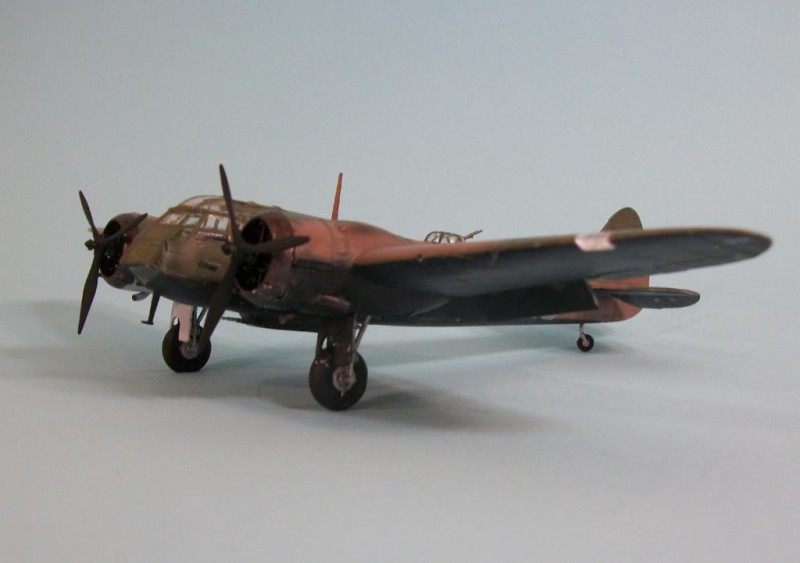
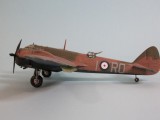
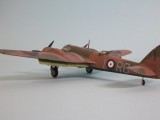
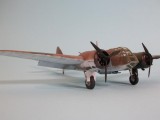
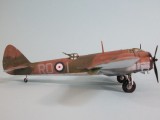
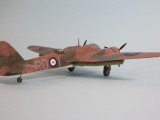

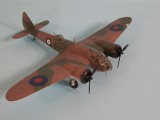
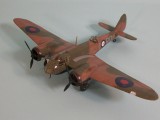

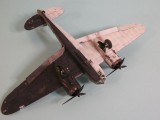
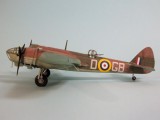
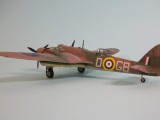
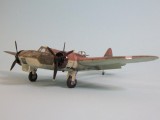
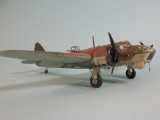
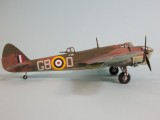
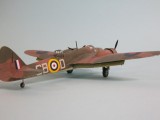
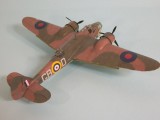
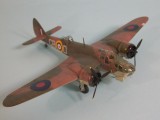
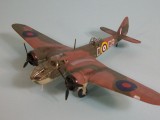
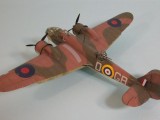
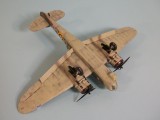



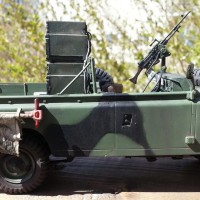
First of these kits I've seen built up. Nice work.
Tom, lovely pair of Blennies. Prewar whole new sheet of paper, overtaken by events/progress. Shame, its a good looking aircraft. Be nice to have a 1/48th of either. Airfix gives you some unnamed parts, so you can do other versions, which I like.
Thanks for the bio on WC Edwards, he was quite the guy. He deserved his statue.
I would really be happy to see Airfix take these up to 1/48 the way they did with the Hurricane and are doing with the Defiant.
Tom. Another kit I've been contemplating adding to my stack. Nice to see a couple build up. Thanks for the article here. Nice work on both.
Great write-up and models. Happy New Year.
Nice brace of Blenheims!
🙂 ... Greetings ... 🙂 :
Very nice work on those Blenheim's, one can sense a piece of history.
Very nice work Tom.
Nice work Tom! Those are great little kits.